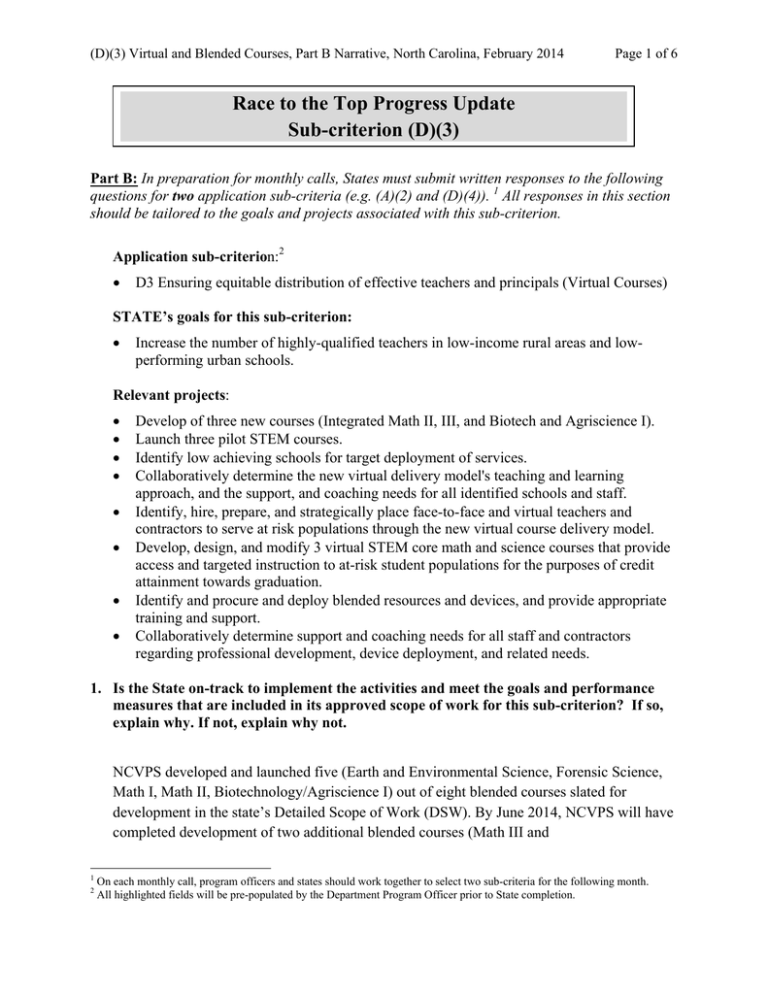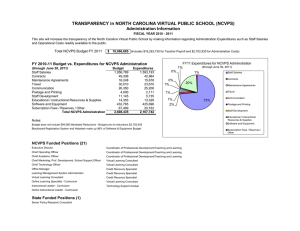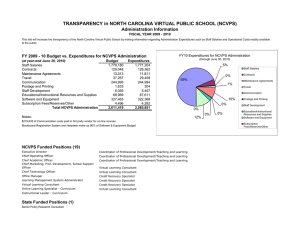Race to the Top Progress Update Sub-criterion (D)(3)
advertisement

(D)(3) Virtual and Blended Courses, Part B Narrative, North Carolina, February 2014 Page 1 of 6 Race to the Top Progress Update Sub-criterion (D)(3) Part B: In preparation for monthly calls, States must submit written responses to the following questions for two application sub-criteria (e.g. (A)(2) and (D)(4)). 1 All responses in this section should be tailored to the goals and projects associated with this sub-criterion. Application sub-criterion:2 • D3 Ensuring equitable distribution of effective teachers and principals (Virtual Courses) STATE’s goals for this sub-criterion: • Increase the number of highly-qualified teachers in low-income rural areas and lowperforming urban schools. Relevant projects: • • • • • • • • Develop of three new courses (Integrated Math II, III, and Biotech and Agriscience I). Launch three pilot STEM courses. Identify low achieving schools for target deployment of services. Collaboratively determine the new virtual delivery model's teaching and learning approach, and the support, and coaching needs for all identified schools and staff. Identify, hire, prepare, and strategically place face-to-face and virtual teachers and contractors to serve at risk populations through the new virtual course delivery model. Develop, design, and modify 3 virtual STEM core math and science courses that provide access and targeted instruction to at-risk student populations for the purposes of credit attainment towards graduation. Identify and procure and deploy blended resources and devices, and provide appropriate training and support. Collaboratively determine support and coaching needs for all staff and contractors regarding professional development, device deployment, and related needs. 1. Is the State on-track to implement the activities and meet the goals and performance measures that are included in its approved scope of work for this sub-criterion? If so, explain why. If not, explain why not. NCVPS developed and launched five (Earth and Environmental Science, Forensic Science, Math I, Math II, Biotechnology/Agriscience I) out of eight blended courses slated for development in the state’s Detailed Scope of Work (DSW). By June 2014, NCVPS will have completed development of two additional blended courses (Math III and 1 2 On each monthly call, program officers and states should work together to select two sub-criteria for the following month. All highlighted fields will be pre-populated by the Department Program Officer prior to State completion. (D)(3) Virtual and Blended Courses, Part B Narrative, North Carolina, February 2014 Page 2 of 6 Biotechnology/Agriscience II) and has requested a “no cost extension” to pilot these two courses during the 2014-15 school year. This will bring the total number of courses completed to seven over the course of the RttT grant period. NCVPS had planned to develop an eighth blended course, Discrete Math, but multiple delays experienced by the initiative have created a situation in which NCDPI is now considering revising its plan to reflect completion of only the seven courses described above. The first type of delay NCVPS experienced involved human resources and contractual issues that slowed the hiring of course developers. It took longer than expected to receive approval to advertise for positions, and the hiring for developers in summer 2013 for one course fell through due to a conflict with the secondary employment policies in the university system, meaning NCVPS had to restart the search process. This delayed revisions to the Math I course and the development of Math II and Biotechnology/Agriscience I courses for the 2013-14 school year. NCVPS had to pilot the Math II course in a “phased rollout” where the first half of the course materials were available at the beginning of the fall 2013 semester, and the second half of the materials were available midway through the fall semester. NCVPS had to delay the pilot for Biotechnology/Agriscience II until the spring 2014 semester, and also had to use a “phased rollout” approach for this pilot (a curriculum pacing guide was developed for the entire course and shared with the teachers at the beginning so they could plan accordingly). NCVPS has also experienced delays related to the new sequence of secondary math courses implemented in the 2012-13 school year. NCDPI shifted from stand-alone courses (Algebra I and II, Geometry) to integrated courses (Math I, II, and III) that included math concepts from each of these courses beginning with the 2012-13 school year. NCVPS (and LEAs generally) faced challenges in implementing these curricula and knowing how to separate content for the three courses. NCDPI created an unpacking guide in the fall of 2013 that made this process easier for LEAs and for NCVPS to complete revisions to Math I, complete development of Math II, and begin development of Math III. At the same time, NCDPI examined the overlap between fourth level courses such as Discrete Math (which had been developed prior to the adoption of the new Standard Course of Study) and concepts covered in Math I, II, and III. Because of overlap between discrete math and the new courses, NCDPI is planning to seek teacher input in summer 2014 on whether to eliminate or revise discrete math ahead of the 2015-16 school year (when the first group of students who progressed through the new math sequence would need these courses). With this uncertainty about the content for Discrete Math, though, it does not seem to make sense to create a blended course that would possibly repeat a good deal of the content from earlier courses. Finally, NCVPS has also experienced delays because of the approval process for the amended year four budget in the Amendment 15 request submitted to the US Department of Education. In the amended budget, there are funds for revisions to the Forensic Science course, for example, but all initiative budgets for year four have been set at the original, pre- (D)(3) Virtual and Blended Courses, Part B Narrative, North Carolina, February 2014 Page 3 of 6 amendment levels and the NC Office of State Budget and Management has not allowed transfers across budget codes that would cover this work. Delays such as these affect revisions to existing courses, in particular, which are also a part of the state’s DSW for this initiative. There is not an obvious blended course to develop in place of Discrete Math, and rather than adding a course that may not meet the needs of NCVPS or the participating LEAs, NCDPI is considering whether the remaining time would be better spent focusing on the development and piloting (pending no- cost extension approval from USED) of the two remaining courses (Math III and Biotechnology/Agriscience I) and making revisions to these and other courses that will enable them to be useful after the end of the RttT grant (e.g., making revisions to materials so LEAs can continue to use them or making revisions to convert blended courses to virtual courses or integrate blended courses with existing NCVPS courses). The need for this potential change became apparent after submission of the Amendment 15/No Cost Extension request to USED; if NCDPI decides to pursue this course of action, we will draft and submit a formal amendment request for the DSW in the coming weeks. Aside from the delays in developing the eighth course, NCVPS has made progress in implementing the five completed courses. NCVPS hired three STEM Course Development Coordinators in the spring of 2014 to assist in quality assurance and alignment to NCVPS Instructional Design Standards for the soon to be developed (Biotechnology/Agriscience II, Math III) or revised (Forensic Science) STEM Courses. NCVPS also completed iBooks for current courses for use in the spring 2014 semester. NCVPS submitted a Request for Proposal (RFP) for two mobile applications (a STEM lab application and a gradebook application) in September 2013; NC ITS provided feedback on these in February 2014, and NCVPS has begun to make changes to the proposal and resubmit it to NC ITS. NCVPS has also continued to develop mobile applications to support students and teachers in blended courses. NCVPS revised the STEM “Getting Started” unit to include more information on STEM frameworks; an overview of Project Based Learning and Blended Learning for Students; an introduction to iPad applications and other tools students use in the course; frequently used terms in the courses; and specific how-tos related to using the iBooks, Moodle and how to use the courses in a mobile format. These changes are designed to help students better understand course connections to STEM and to participate effectively in the course. NCVPS formed a STEM Leadership and Project Management team in the late summer of 2013 to collaboratively evaluate and analyze the blended course delivery model's teaching and learning approach, and the support, and coaching needs for all identified schools and staff. All team members assist with identifying, hiring, preparing, and strategically placing face-to-face and virtual teachers and contractors to serve at risk populations via the blended course delivery model. The STEM Project Management Team has also continued to identify, (D)(3) Virtual and Blended Courses, Part B Narrative, North Carolina, February 2014 Page 4 of 6 procure and deploy blended resources and devices, and provide appropriate professional learning and support. STEM Professional Learning continues to be offered for both NCVPS and LEA face-to-face teachers. 2. Does the State have evidence indicating the quality of implementation for this subcriterion? What is/has the State doing/done as a result of this information? One way NCVPS tracks the quality of implementation is by looking at enrollment figures. Tables 1 and 2 below provide the enrollment figures for the blended courses offered in the fall 2013 and spring 2014 semesters in each participating LEA. These are consistent with enrollments from the 2012-13 school year. Table 1: Fall 2013 Enrollment in Blended STEM Courses Greene New Hanover Person Subject Total Math I 16 26 N/A 42 Math II 22 N/A N/A 22 Forensic Science 13 20 20 53 Earth & Environmental Science (EES) 16 16 26 58 LEA Total 67 62 46 175 Table 2: Spring 2014 Enrollment in Blended STEM Courses Greene New Hanover Person Subject Total Math I 15 15 N/A Math II 14 10 N/A 30 24 Forensic Science N/A 19 11 30 EES 14 15 N/A 29 Biotech I 17 N/A 20 37 LEA Total 60 59 31 150 The main set of indicators for determining the quality of implementation continues to come from informal feedback collected by NCVPS staff and the co-teachers working together. NCVPS uses a mixture of virtual meetings and site visits to get feedback on implementation activities as they progress. Virtual and face-to-face teachers utilize Google Hangout sessions and Blackboard Collaborate to participate in e-Learning Communities to share ideas, discuss challenges, and reflect on Professional Learning. The Project Manager meets weekly with each team member to discuss feedback, tasks, and priorities. A STEM Leadership Team meeting is held once a month to evaluate project goal progress and discuss implementation strategies and results. NCVPS staff members also conduct site visits to observe the implementation and gather feedback on integration and sustainability, and each virtual (D)(3) Virtual and Blended Courses, Part B Narrative, North Carolina, February 2014 Page 5 of 6 teacher has four spot checks a semester. The face-to-face teachers and virtual teacher communicate daily on issues, concerns, and successes through a daily communication log of information in order to monitor implementation of the course and make adjustments based on the needs of the students in the class. This is accessible to the STEM Instructional Leader and the STEM Project Manager. Based on formative feedback provided through these methods, NCVPS has seen the following positive trends: • Collaboration between virtual and face-to-face teachers is working well as they are using their daily logs to communicate about the course and face-to-face teachers are taking ownership of their role in the courses. • Integration of technology tools and online resources is growing, and NCVPS has created additional resources to help teachers and students use course technology effectively (changes described under the response to question one above). • LEAs are examining the possibility of integrating courses into their general catalogue after the pilot phase has ended. Greene County is developing a STEM program which will include NCVPS virtual STEM courses and are currently piloting their own STEM program in middle school. In addition to the informal feedback obtained through internal NCVPS procedures, a team from the Friday Institute at NC State continues to conduct evaluations and collect data regarding the implementation of the project. The most current evaluation results were released in the Spring of 2013 and recommended that NCVPS should: • Provide additional pre-course support and guidance for teachers with course material, strategies for managing student interactions with technology, managing project-based learning classrooms, etc. • Provide additional support and guidance for students (e.g., technology training) • Restructure iPad integration (e.g., compatibility, novelty) • Clearly define the roles of and increase the involvement of online teachers • Continue to improve course content • Develop relationships with others working on similar blended learning initiatives NCVPS worked to make these changes over the past year, and made extensive progress (described in the response to question one) during the fall of 2013. In particular, NCVPS has revised its “Getting Started” unit and added professional learning for teachers to help address these concerns. 3. What obstacles and/or risks could impact the State’s ability to meet its goals and performance measures related to this sub-criterion? See response to question one. (D)(3) Virtual and Blended Courses, Part B Narrative, North Carolina, February 2014 Page 6 of 6 Evaluation: Based on the responses to the previous question, evaluate the State’s performance and progress to date for this sub-criterion (choose one) Red (1) Orange (2) Yellow (3) Green (4)3 3 Red – substantially off-track and/or has significant quality concerns; urgent and decisive action is required; Orange –off-track and/or there are quality concerns; many aspects require significant attention; Yellow –generally on-track and of high or good quality; only a few aspects require additional attention; Green – on-track with high quality.

